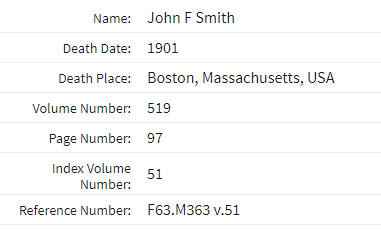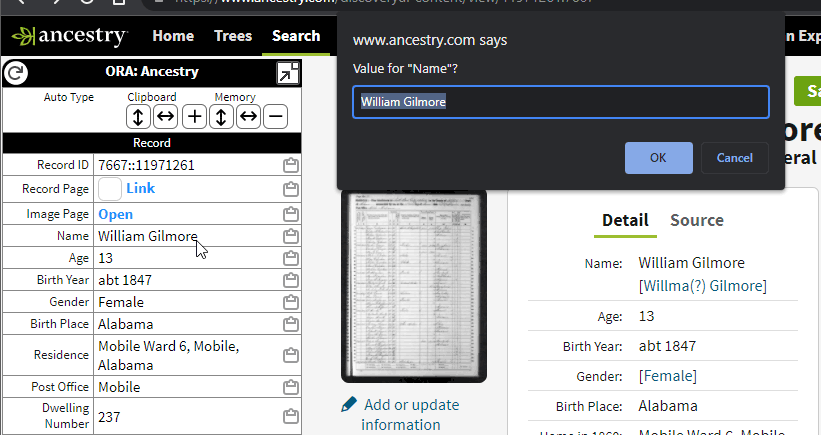Overview
Fields represent values extracted from record detail pages or values added by the ORA user.
When extracting Fields from a record detail page, ORA finds Field values in various places, but a common source is a table of Field labels and values as seen in this example taken from Ancestry:

ORA extracts the Field name and value and adds them to the OraPanel:

Most Fields are visible in the OraPanel, but some are intended for use in templates and are not visible.
ORA does not have a pre-defined dictionary of Fields that occur in the collections of the supported repositories. It detects Fields by looking at the content of pages that include record details.
Editing Field Values
You may edit the value of a Field by clicking on the value while pressing Alt. ORA will open a small prompt near the top of the browser window where you can edit the value.

ORA will refresh the OraPanel after updating the Field value. The User Field Styles will be applied to the row whose value you edited. Any values you enter will persist until you refresh the page. You may refresh the OraPanel without losing your changes.
If you cancel the prompt, ORA will not change the existing value.
Field Groups
Fields are assigned to one of several groups.
- Record group: Fields extracted from the page that pertain to the record being viewed.
- Source group: Fields extracted from the page that pertain to the source or collection to which the record belongs.
- Page group: Fields extracted from the HTML of the page or generated at the time the page is viewed.
Record Group
ORA creates the Fields in the Record group as it inspects the contents of the page and finds values that are specific to the current record. The Field names are specific to the current repository, collection, and record. Field names will be somewhat consistent from one record to another in the same collection, but they will vary based on differences between records.
When referring to Fields in the Record group in a template, do not include the group name in a prefix. So, use [Name] and not [Record.Name].
Collection Fields
Most repositories group records into collections where the collection is a set of records drawn from a common source. So, for example, an example of a collection is the 1940 Federal Census of the United States.
ORA detects the current record's collection and assigns two collection-related Fields:
| Field | Description |
|---|---|
| Collection Name | The name of the current collection. |
| Collection ID | The ID of the current collection. It may be a number or some other value that uniquely identifies the collection. |
Those Fields are hidden, i.e., they do not appear in the OraPanel, but you may refer to their values in Templates using [Collection Name] and [Collection ID].
Some repositories do not have multiple collections or may not provide a unique identifier for a collection. For those repositories, ORA arbitrarily assigns the collection names and IDs. For Find A Grave, for example, ORA defines two collections, "Memorials" and "Cemeteries".
Some repositories provide explicit source information on record pages. The repository may indicate a Source Title or Source Name, and in some cases, that value is different from the Collection Name assigned by ORA. Typically, if ORA includes a Source.Title or Source.Name Field in the OraPanel, you should use that Field when you record the source in your genealogy program rather than the Collection Name or Collection ID.
Source Group
ORA creates the Fields in the Source group as it inspects the contents of the page and finds values that describe the collection to which the record belongs. The Field names are specific to the current collection and may or may not be consistent with other collections in the same repository.
When referring to Fields in the Source group in a template, you must include the group name in a prefix. So, use [Source.Title] to refer to the Title Field in the Source group.
Page Group
ORA creates several Fields in the Page group. These Fields are usually hidden, but may be used in Text Templates and Auto Type Templates. The values are hidden because most of them are drawn from HTML values that are often duplicated by other values that ORA extracts from the page.
When referring to Fields in the Page group in a template, you must include the group name in a prefix. So, use [Page.Access Date] to refer to the Access Date Field in the Page group.
| Field | Description |
|---|---|
| Page.Access Date | The current date, useful when citations include the current date. |
| Page.ServiceName | The name of the ORA service ("Ancestry", "Find a Grave", etc.). |
| Page.HostName | The domain from the current page's URL. ORA removes "www." if it exists. |
| Page.Title | The value is extracted from the HTML TITLE element. For many pages, the HTML TITLE element includes both the page title and the site name, and that makes the value less useful than if it contained only the page title. In many cases, ORA will extract a title that is better than the value of the HTML TITLE element. That value will be in the Record group as the Title element. In still other cases, a page title is not useful in a source or citation, and a person's name or other text extracted directly from the record is used in place of a page title. |
| Page.URL | The value is extracted from the canonical HREF provided in a LINK element with rel="canonical". If that does not exist, the value is the URL shown in the browser's address bar. ORA will include a URL Field in the Record group, and that URL will usually be better. For example, when repositories support direct links to a specific record, the URL Field in the Record group will use that value, and that is the value you should use when including a URL in a citation. |
| Page.Visible URL | The value is the URL shown in the browser's address bar. This is an alternate to Page.URL that is useful when the canonical URL provided by the page is less detailed than the visible URL shown in the browser's address bar. |